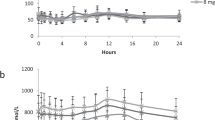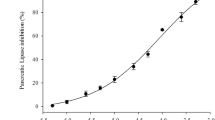Abstract
Kynurenic acid (KYNA) is an agonist of the G-protein-coupled receptor GPR35, which is predominantly expressed in gastrointestinal tissues. The aim of this study was to determine the content of KYNA in gastric juice, bile and pancreatic juice and intestinal content. KYNA was determined by means of high performance liquid chromatography. The mean concentrations of KYNA in human gastric juice is 9.91 ± 0.71 nM in contrast to human bile (832.5 ± 204.1 and 306.8 ± 35.2 nM) obtained from patients with cholecystolithiasis and obstructive jaundice, respectively. In pigs, the KYNA levels in bile and pancreatic juice are 1,113.3 ± 63.34 and 757.0 ± 394.4 nM, respectively. The KYNA concentration increases along the digestive system, reaching 1,638 nM in the colon content. We suggest that the liver and pancreas affect the content of kynurenic acid in the lumen of the digestive tract.



Similar content being viewed by others
References
Assimakopoulos SF, Thomopoulos KC, Patsoukis N, Georgiou CD, Scopa CD, Nikolopoulou VN et al (2006) Evidence for intestinal oxidative stress in patients with obstructive jaundice. Eur J Clin Invest 36:181–187. doi:10.1111/j.1365-2362.2006.01616.x
Birch PJ, Grossman CJ, Hayes AG (1988) Kynurenic acid antagonises responses to NMDA via an action at the strychnine-insensitive glycine receptor. Eur J Pharmacol 154:85–87. doi:10.1016/0014-2999(88)90367-6
Cingi A, Ahiskali R, Oktar BK, Gülpinar MA, Yegen C, Yegen BC (2002) Biliary decompression reduces the susceptibility to ethanol-induced ulcer in jaundiced rats. Physiol Res 51:619–627
Costa CV, Ragazzi E, Caparrotta L, Bertazzo A, Biasiolo M, Allegri G (1999) Liver and kidney kynurenine aminotransferase activity in different strains of rats. Adv Exp Med Biol 467:629–635
Delegge MH (2008) Enteral feeding. Curr Opin Gastroenterol 24:184–189. doi:10.1097/MOG.0b013e3282f4dbab
Georgiev P, Navarini AA, Eloranta JJ, Lang KS, Kullak-Ublick GA, Nocito A et al (2007) Cholestasis protects the liver from ischaemic injury and post-ischaemic inflammation in the mouse. Gut 56:121–128. doi:10.1136/gut.2006.097170
Glavin GB, Bose R, Pinsky C (1989) Kynurenic acid protects against gastroduodenal ulceration in mice injected with extracts from poisonous Atlantic shellfish. Prog Neuropsychopharmacol Biol Psychiatry 13:569–572. doi:10.1016/0278-5846(89)90148-6
Glavin GB, Pinsky C (1989) Kynurenic acid attenuates experimental ulcer formation and basal gastric acid secretion in rats. Res Commun Chem Pathol Pharmacol 64:111–119
Glavin GB, Pinsky C, Bose R (1990) Gastrointestinal effects of contaminated mussels and putative antidotes thereof. Can Dis Wkly Rep 16(Suppl 1E):111–115
Hilmas C, Pereira EF, Alkondon M, Rassoulpour A, Schwarcz R, Albuquerque EX (2001) The brain metabolite kynurenic acid inhibits alpha7 nicotinic receptor activity and increases non-alpha7 nicotinic receptor expression: physiopathological implications. J Neurosci 21:7463–7473
Kaszaki J, Palasthy Z, Erczes D, Racz A, Torday C, Varga G et al (2008) Kynurenic acid inhibits intestinal hypermotility and xanthine oxidase activity during experimental colon obstruction in dogs. Neurogastroenterol Motil 20:53–62
Kilicoglu B, Gencay C, Kismet K, Serin KS, Erguder I, Erel S et al (2008) The ultrastructural research of liver in experimental obstructive jaundice and effect of honey. Am J Surg 195:249–256. doi:10.1016/j.amjsurg.2007.04.011
Kuc D, Rahnama M, Tomaszewski T, Rzeski W, Wejksza K, Urbanik-Sypniewska T et al (2006) Kynurenic acid in human saliva: does it influence oral microflora? Pharmacol Rep 58:393–398
Kuc D, Zgrajka W, Parada-Turska J, Urbanik-Sypniewska T, Turski WA (2008) Micromolar concentration of kynurenic acid in rat small intestine. Amino Acids 35:503–505. doi:10.1007/s00726-007-0631-z
Liu MT, Rothstein JD, Gershon MD, Kirchgessner AL (1997) Glutamatergic enteric neurons. J Neurosci 17:4764–4784
Milart P, Sikorski R (1998) Kynurenic acid concentration in blood and urine during normal pregnancy. Ginekol Pol 69:968–973
Moroni F, Fossati S, Chiarugi A, Cozzi A (2007) Kynurenic acid actions in brain and periphery. Int Congr Ser 1304:305–313
Pacha J (2000) Development of intestinal transport function in mammals. Physiol Rev 80:1633–1667
Pierzynowski SG, Weström BW, Karlsson BW, Svendsen J, Nilsson B (1988) Pancreatic cannulation of young pigs for long-term study of exocrine pancreatic function. Can J Anim Sci 68:953–959
Sabuncuoglu MZ, Kismet K, Kilicoglu SS, Kilicoglu B, Erel S, Muratoglu S et al (2007) Propolis reduces bacterial translocation and intestinal villus atrophy in experimental obstructive jaundice. World J Gastroenterol 13:5226–5231
Scopa CD, Koureleas S, Tsamandas AC, Spiliopoulou I, Alexandrides T, Filos KS et al (2000) Beneficial effects of growth hormone and insulin-like growth factor I on intestinal bacterial translocation, endotoxemia, and apoptosis in experimentally jaundiced rats. J Am Coll Surg 190:423–431. doi:10.1016/S1072-7515(99)00285-9
Turski MP, Turska M, Zgrajka W, Kuc D, Turski WA (2008) Presence of kynurenic acid in food and honeybee products. Amino Acids. doi:10.1007/s00726-008-0031-z
Turski WA, Nakamura M, Todd WP, Carpenter BK, Whetsell WO Jr, Schwarcz R (1988) Identification and quantification of kynurenic acid in human brain tissue. Brain Res 454:164–169. doi:10.1016/0006-8993(88)90815-3
Wang J, Simonavicius N, Wu X, Swaminath G, Reagan J, Tian H et al (2006) Kynurenic acid as a ligand for orphan G protein-coupled receptor GPR35. J Biol Chem 281:22021–22028. doi:10.1074/jbc.M603503200
Acknowledgments
Technical assistance from Franciszek Wysocki, MD, Department of Surgery, Regional Hospital, Lublin, Poland, is gratefully acknowledged.
Author information
Authors and Affiliations
Corresponding author
Rights and permissions
About this article
Cite this article
Paluszkiewicz, P., Zgrajka, W., Saran, T. et al. High concentration of kynurenic acid in bile and pancreatic juice. Amino Acids 37, 637–641 (2009). https://doi.org/10.1007/s00726-008-0183-x
Received:
Accepted:
Published:
Issue Date:
DOI: https://doi.org/10.1007/s00726-008-0183-x




